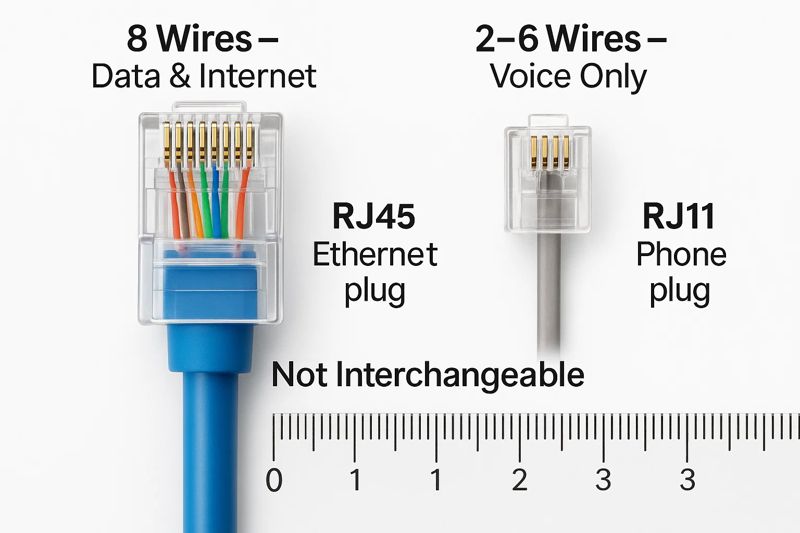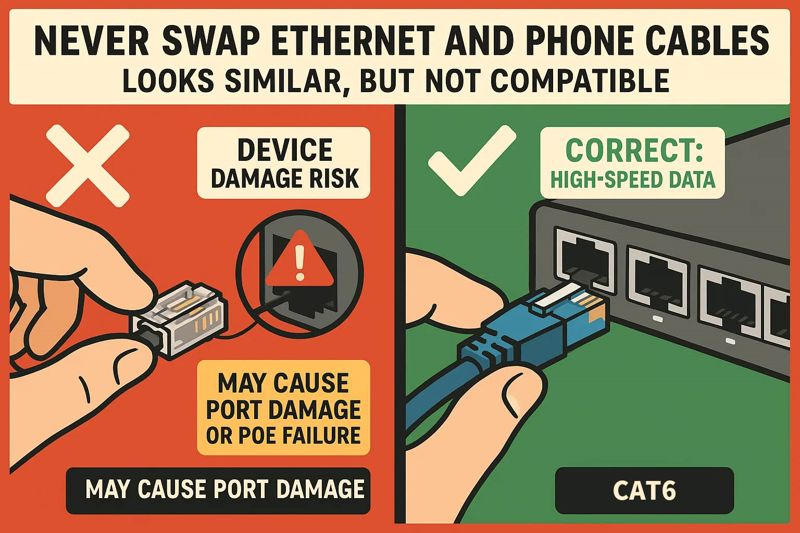Cable & Wire | High quality and excellent service at reasonable prices.
info@zion-communication.com
Author: Will Publish Time: 07-08-2025 Origin: Site
Network cables are a prominent feature in modern living and working environments, comprising homes, offices, production facilities, and storage facilities. However, there is still an irritating question and complicating matter:
Which is which, Ethernet or phone cable: What is the difference, and how?
Although they appear alike at first, using the wrong cable might cause latency, failed connection, or in the worst-case scenario, could damage your devices. In this article, we'll show you the cable type's distinction and what cable you should buy in order to make a good choice for your home network.

An Ethernet cable is a kind of network cable used for data transmission in local area networks (LANs). It connects computers, routers, switches, and other devices to the internet or to one another.
Connector Type: RJ45, 8P8C Connections
Wiring: 8 wires consisting of twisted pairs; 4 twisted pairs.
Speed Support: 10 Mbit/s, 100 Mbit/s, 1 Gbit/s, and more (< 10 Gb/s) in Cat6a or Cat7 standards
Typical Use: Internet access will be using it for online gaming, watching various online shows and movies, file transfers, VoIP calls.
Some of the common types are Cat5e, Cat6, Cat6a, and Cat7. The successive standards enable higher speeds and even greater capacity.
A phone cable is a line used for voice transmission, and mostly, it connects to the loop in landline phones or DSL modems.
Connector Type: The RJ11 (4P4C) or RJ11 (6P2C).
Wiring: 2 to 6 wire pairs (none-foliated wires usually).
Speed Support: Voice or low-rate DSL only are possible (up to 10 Mbps throughput).
Typical Use: Also used for analog voice communication, fax machines, DSL modems.
Phone cables do not have the bit rate and signal speed that Ethernet networking needs.
No. The phone cable cannot substitute the Ethernet one.
Telephone cables are devoid of the wire pairs that depend on them to transmit Ethernet data.
They support a very lightweight signal that is extremely unsuitable for digital data transfer.
An RJ11 plugged into an RJ45 will look like it fits physically, but it won't work, so that their equipment can get damaged.

It might work out in some situations, but with some limitations.
Ethernet cables contain a majority of wires more than phone lines, so if possibly interchanged or linked, voice signals can be transmitted. It has been found that certain types of telecom circuits apply RJ45 jacks for voice. In structured cabling systems, companies often use Ethernet cabling (which uses the same RJ45 connectors).
Using a standard phone for it is not recommended.
It may be required that certain adapters be used or that the pin-out be modified.
Through three simple checks, be sure to:
RJ45, Ethernet, is wider than RJ11, Which Is Used for Phone Lines.
Ethernet: 8 wires
Phone: either 2 or 6 wires.
Ethernet cabling has likely the labelings of Cat5e, Cat6, and so forth.
The rightly selected cable ensures:
Fast internet speed
Fewer data errors and interference
Equipment safety and outlet alternative compatibility
Confusing phone cable with Ethernet could be a time-consuming network problem, or damaging connectors as well as you inform POE systems.
So, answering the question,
Ethernet cables are dedicated to data transfer and internet access, while phone lines are solely intended for voice communication.
Phone lines are used for voice transmission and DSL is a digital transmission medium.
Since connectors have similar plugs, they cannot be interchangeable.
Remember: Always take the right cable into consideration to meet the specification of your device.
No. They have several wires, which are different from Ethernet cables, and the cords are relatively smaller.
You can give it a try, but it simply wouldn't do the job and may lead to damaging the above mentioned parts.
Technically it is true, if dedicated for that task, should be the only reason why it is considered normal activity.
Offers from Zion Communication include structured cabling and networking products, being a well-reputed supplier. With more than 10 years of experience in the telecom field and data services industry, we focus on providing high-quality, high-speed broadband services for both home and businesses, and also ISPs.
We ensure that the authors of our articles have enough knowledge and expertise in the technical area in question so that you can have an algorithm in front of you which supplies the most specified, accurate, reliable information.
Contact us for more information

Will is the Copper Cabling Product Manager at Zion Communication,
specializing in the development and marketing of Ethernet cabling solutions.
With extensive industry experience, he is dedicated to delivering high-performance
and reliable cabling products to OEM/ODM clients worldwide.
will@zion-communication.com
+86 -18268007201
